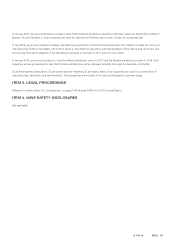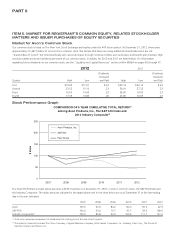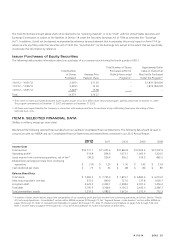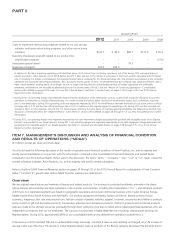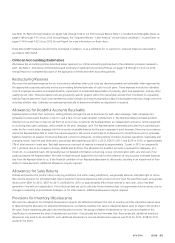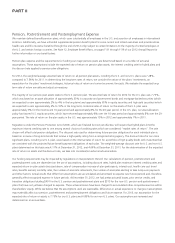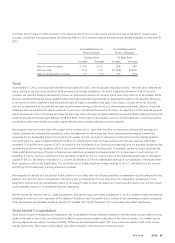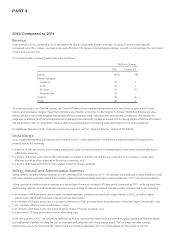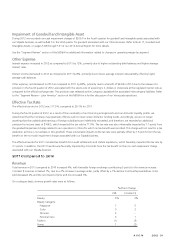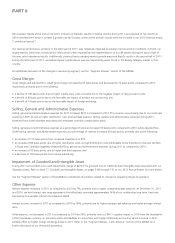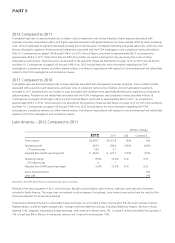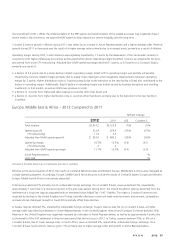Avon 2012 Annual Report Download - page 35
Download and view the complete annual report
Please find page 35 of the 2012 Avon annual report below. You can navigate through the pages in the report by either clicking on the pages listed below, or by using the keyword search tool below to find specific information within the annual report.PART II
Loss Contingencies
We determine whether to disclose and/or accrue for loss contingencies based on an assessment of whether the risk of loss is remote,
reasonably possible or probable. Our assessment is developed in consultation with our outside counsel and other advisors and is based on an
analysis of possible outcomes under various strategies. Loss contingency assumptions involve judgments that are inherently subjective and
can involve matters that are in litigation, which, by its nature is unpredictable. We believe that our assessment of the probability of loss
contingencies is reasonable, but because of the subjectivity involved and the unpredictable nature of the subject matter at issue, our
assessment may prove ultimately to be incorrect, which could materially impact the Consolidated Financial Statements.
Goodwill and Intangible Assets
We test goodwill and intangible assets with indefinite lives for impairment annually, and more frequently if circumstances warrant, using
various fair value methods. We review finite-lived intangible assets, which are subject to amortization, for impairment whenever events or
changes in circumstances indicate that the related carrying amounts may not be recoverable.
We completed our annual goodwill impairment assessment for 2012 during the year-end close process and determined that the estimated
fair values were considered substantially in excess of the carrying values of each of our reporting units, with the exception of our Silpada and
China reporting units.
Our analysis of the Silpada business indicated an impairment as the carrying value of the business exceeded the estimated fair value and the finite-
lived intangible assets were not recoverable. This was primarily the result of the weaker than expected performance in the fourth quarter of 2012,
largely due to lower Representative counts and activity rates, and as a result we lowered our revenue and earnings projections for Silpada.
Accordingly, a non-cash impairment charge of $209 was recorded to reduce the carrying amounts of goodwill, an indefinite-lived intangible asset,
and a finite-lived intangible asset. At December 31, 2012, as a result of the impairment charge recorded, the carrying values of Silpada’s goodwill,
indefinite-lived intangible asset, and finite-lived intangible asset were $45, $40, and $40 respectively. The decline in the fair values of the Silpada
assets was driven by the reduction in the forecasted growth rates and cash flows used to estimate their respective fair values.
Our annual analysis, completed during the year-end close process, of the China business indicated that the estimated fair value exceeded its
carrying value by approximately 19%. The goodwill associated with China was $38 at December 31, 2012. During the third quarter of 2012,
based on the continued decline in revenue performance in China, and a corresponding lowering of our long-term growth estimates in
China, we completed an interim impairment assessment of the fair value of goodwill related to our operations in China. The results of our
interim impairment test indicated the estimated fair value of our China reporting unit was less than its respective carrying amount.
Accordingly, a non-cash impairment charge of $44 was recorded to reduce the carrying amount of goodwill to its estimated fair value. The
changes to our long-term growth estimates were based on the state of our China business, which was predominantly retail at that time.
During the 2011 year-end close process, our analysis of the Silpada business indicated an impairment as the carrying value of the business
exceeded the estimated fair value. Accordingly, a non-cash impairment charge of $263 was recorded in the fourth quarter of 2011 to reduce
the carrying amounts of goodwill and an indefinite-lived intangible asset. Following weaker than expected performance in the fourth quarter
of 2011, we lowered our revenue and earnings projections for Silpada largely due to the rise in silver prices, which nearly doubled since the
acquisition, and the negative impact of pricing on revenues and margins. The decline in the fair values of the Silpada reporting unit and the
underlying trademark was driven by the reduction in the forecasted growth rates and cash flows used to estimate their respective fair value.
The impairment analyses performed for goodwill and intangible assets require several estimates in computing the estimated fair value of a
reporting unit, an indefinite-lived intangible asset, and a finite-lived intangible asset. We use a discounted cash flow (“DCF”) approach to
estimate the fair value of a reporting unit, which we believe is the most reliable indicator of fair value of a business, and is most consistent
with the approach a market place participant would use. The estimation of fair value utilizing a DCF approach includes numerous
uncertainties which require our significant judgment when making assumptions of expected growth rates and the selection of discount
rates, as well as assumptions regarding general economic and business conditions, and the structure that would yield the highest economic
value, among other factors. Key assumptions used in measuring the fair values of Silpada and China included the discount rate (based on
the weighted-average cost of capital) and revenue growth, as well as silver prices and Representative growth and activity rates for Silpada.
The fair value of Silpada’s indefinite-lived trademark was determined using a risk-adjusted DCF model under the relief-from-royalty method.
The royalty rate used was based on a consideration of market rates. The fair value of the Silpada finite-lived customer relationships was
determined using a DCF model under the multi-period excess earnings method. A significant decline in expected future cash flows and
growth rates or a change in the discount rate used to fair value expected future cash flows may result in future impairment charges.



